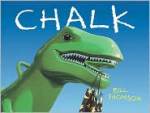Archive for May 2010
A Stunning Wordless Book
Posted on: May 28, 2010
Chalk by Bill Thomson. (2010). Marshall Cavendish Children. Pages not numbered. Grades K-5. Wordless Picture Book.
Wordless picture books engage and delight young readers. Children just beginning to read acquire a sense of story. Proficient readers gain an opportunity to predict and make inferences as the story unfolds. Children pour over the illustrations in a wordless picture book to notice details and tell the story in their own words.
Chalk is soon to be a classic that will enthrall generations of youngsters. The story has universal appeal for all ages. It’s a rainy day and three children garbed in rain gear enter a park for an unexpected, imaginative, adventure. Hanging from one of the playground toys is a bag filled with colored chalk. Each child selects a piece to make a picture. The first girl chooses yellow and draws a big sun on the sidewalk. Suddenly, a bright sun dazzles the three as it burns away the clouds and dries up the rain. The next girl draws butterflies that come to life. The children are delighted to play with the wing creatures! Finally the boy selects green to create a T-Rex on the pavement that looks like the playground dinosaur. Suddenly, a large dinosaur shadow looms over the children as they scamper for safety in the playground tunnel. The huge dinosaur with scary, sharp teeth and talons appears ready to eat them. The boy creates a picture on the inside of the tunnel showing a rainy day and thunder clouds appear in the sky. The rain beats down and the T-Rex dissolves into the puddles. The three end their adventure when they hang the bag of chalk for the next children to find.
Thomson’s pictures are vividly realistic. He uses brightly acrylics and soft colored pencils to create paintings that pop. The illustrations are large and can be seen across a classroom. Five insets within the larger pictures provide close-ups of the action. Thomson varies the perspective of the viewer, sometimes the paintings show one of the three character’s view. Other times, the view looks down on the child and the action. The three children are of varied races. Involve your children in telling the story as you ask them questions about what they see in the pictures. Enjoy Thomson’s other books, Karate Hour and Baseball Hour for realistic stories.
A Math Whiz
Posted on: May 15, 2010
Blockhead: The Life of Fibonacci by Joseph D’Agnese. Illustrated by John O’Brien. (2010). Holt. 40 pages. Grades 4 and up. Biography.
Spark children’s interest in math with this biography of Fibonacci who was passionate about numbers. As a boy he could solve math problems in two seconds! When he was in school in 1178 in Italy, students did their math problems on abacuses and wrote their answers in Roman numerals. Because he daydreamed about numbers he was ridiculed and called a Blockhead.
This fascinating biography shows that Fibonacci thought about numbers in “a different way.” He worked hard to introduce Hindu-Arabic numerals to the world. He also discovered a number pattern, now call the Fibonacci Sequence. “That number pattern is a “blueprint that describes how living things such as flowers grow in an orderly, harmonious way.” (p. 39).
The author tells Fibonacci’s story with zest and shows how the mathematician pursued and researched numbers as he traveled to different countries as a merchant. O’Brien’s illustrations compliment and expand the text. More details about what is known about Fibonacci are given at the end of the book along with puzzles to solve in a review of the illustrations. Blockhead should ignite students’ interest in learning more about Fibonacci’s Sequence.

